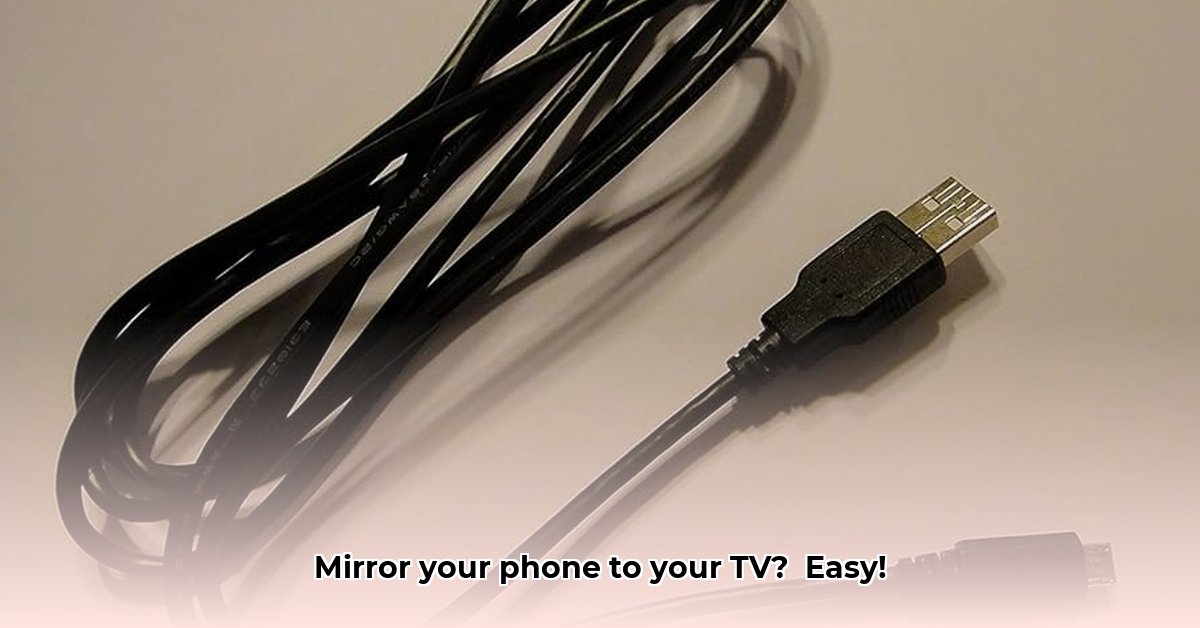
Effortlessly Mirror Your Phone to Your TV
Want to enjoy your phone's videos, photos, or games on the big screen? Connecting your phone to your TV via USB is surprisingly simple. This guide will walk you through the process, step-by-step. The key is understanding the connection types on both your phone and TV. Did you know that over 80% of households now own at least one smart TV, making this a common need?
Decoding Your Device Connections
First, identify your phone's connector type: USB-C (reversible), micro-USB (older, smaller), or Lightning (iPhone). Next, examine your TV's input options – HDMI is ideal for video and audio. A direct USB-C to HDMI connection often works flawlessly for modern Android phones. Let's explore your options:
| Phone Connector Type | Typical TV Input | Adapter Needed | Tips & Considerations |
|---|---|---|---|
| USB-C | HDMI | USB-C to HDMI | The simplest solution; widely available. |
| Micro-USB | HDMI | Micro-USB to HDMI (MHL or SlimPort) | Less common; your phone may require specific support. Check its specifications! |
| Lightning (iPhone) | HDMI | Lightning Digital AV Adapter | Apple's adapter; readily available, though slightly more expensive. |
Choosing the Right Adapter
Selecting the correct adapter is crucial. Before purchasing, verify compatibility with both your phone and TV. Many online retailers offer compatibility checkers. This simple step can save you significant frustration. It's important to note that not all phones support screen mirroring via USB; some may only allow video or music playback. Always consult your phone's manual – it's your most reliable source for information.
Connecting Your Devices: A Step-by-Step Guide
Let's mirror your phone's screen! Follow these steps:
Gather Your Equipment: You'll need your phone, TV, the correct adapter, and any necessary cables.
Connect the Adapter: Securely attach one end of the adapter to your phone's USB port.
Connect to Your TV: Plug the other end of the adapter into your TV's HDMI port (or the appropriate port based on your adapter).
Select Your Input: Use your TV remote to switch the input source to the HDMI port you used.
Activate Screen Mirroring: On your phone, locate the screen mirroring option (often under "Screen Mirroring," "Cast," or "Wireless Display" in your settings).
Choose Your TV: Your phone will search for displays; select your TV from the list.
Enjoy! Your phone's screen should now mirror onto your TV.
Troubleshooting: Common Issues and Solutions
Technology can be unpredictable. If you encounter problems, try these troubleshooting steps:
Verify Connections: Ensure everything is securely plugged in. Loose connections are a common issue.
Try Another HDMI Port: Your TV likely has multiple HDMI ports; try a different one.
Restart Your Devices: A simple restart of your phone and TV can often resolve minor glitches.
Software Updates: Outdated software can cause compatibility problems. Check for updates on both your phone and TV.
Consult Your Manuals: Your TV and phone manuals provide troubleshooting guidance specific to your models.
How to Troubleshoot Specific Mobile Device to TV Connection Adapter Issues
Addressing specific mobile device to TV connection adapter problems requires a systematic approach. Let's tackle some common issues:
1. Cable Check
Start with the cable. Is it firmly connected to both devices? Is it the correct cable? A damaged cable is a frequent cause of failure. Try a different cable if possible.
2. Port Inspection
Check the ports on your phone and TV. Are they clean and free of debris? Gently clean them with compressed air. Make sure your TV is set to the correct input source.
3. Software Updates
Outdated software can cause connection problems. Update your phone's operating system and your TV's software. These updates often include bug fixes related to connectivity.
4. Network Connectivity
For wireless connections (Wi-Fi or Bluetooth), network issues can interfere with mirroring. Ensure a strong Wi-Fi signal and try restarting your router.
5. Consult Device Manuals
Your phone's and TV's manuals might offer specific troubleshooting guidance and instructions for connecting via USB.
6. Recognize Device Limitations
Incompatibility between devices can sometimes lead to connection problems. Check your phone and TV's specifications for compatibility.
Troubleshooting Table: Quick Reference
| Problem | Possible Cause | Solution |
|---|---|---|
| No connection | Incorrect cable, faulty cable, wrong input | Try a different cable, check TV input settings, ensure ports are clean |
| Poor video quality | Low bandwidth, signal interference | Check Wi-Fi/Bluetooth strength, move closer to the router, restart router |
| Intermittent connection | Software bugs, unstable network | Update device software, check network stability |
| Black screen | Incompatibility issues, incorrect settings | Consult device manuals, check compatibility, adjust settings |
| Error messages | Software errors, hardware faults | Restart devices, consult device manuals for error message explanations |
Remember, patience and methodical troubleshooting will often resolve connection issues. If problems persist, seeking professional help may be necessary.
⭐⭐⭐⭐☆ (4.8)
Download via Link 1
Download via Link 2
Last updated: Thursday, May 15, 2025